How to choose an area rug is a crucial step in home decorating. If you’re looking to add a touch of style, warmth, and personality to your home, one of the easiest and most effective ways to achieve this is by incorporating an area rug into your interior design. An area rug can transform a space, bringing together different elements and creating a cohesive look. However, choosing and arranging an area rug can be a daunting task.

With the right guidance, though, you can select the perfect rug that complements your home decor and creates a stunning visual impact. In this article on how to choose and arrange an area rug, we will explore various aspects of selecting and placing a rug in your home, providing you with expert tips and practical advice every step of the way.
How to Choose and Arrange an Area Rug in Your Home
Choosing an area rug involves more than just picking something that catches your eye. To ensure a harmonious and visually pleasing result, consider the following factors:
1. Assess the Room’s Purpose and Layout
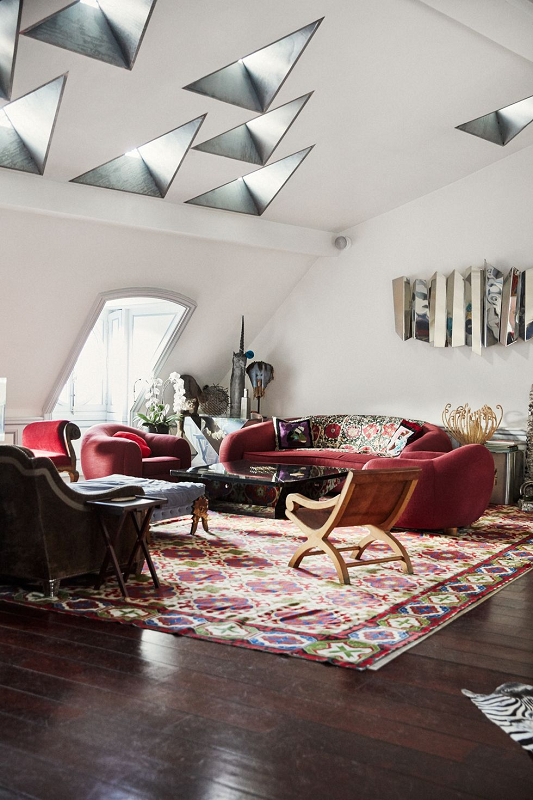
Before diving into the world of area rugs, take a moment to assess the purpose and layout of the room you are decorating. Are you looking to create a cozy ambiance in your living room or add a pop of color to your bedroom? Understanding the room’s function and layout will help you determine the appropriate rug size, shape, and style.
2. Determine the Rug Size
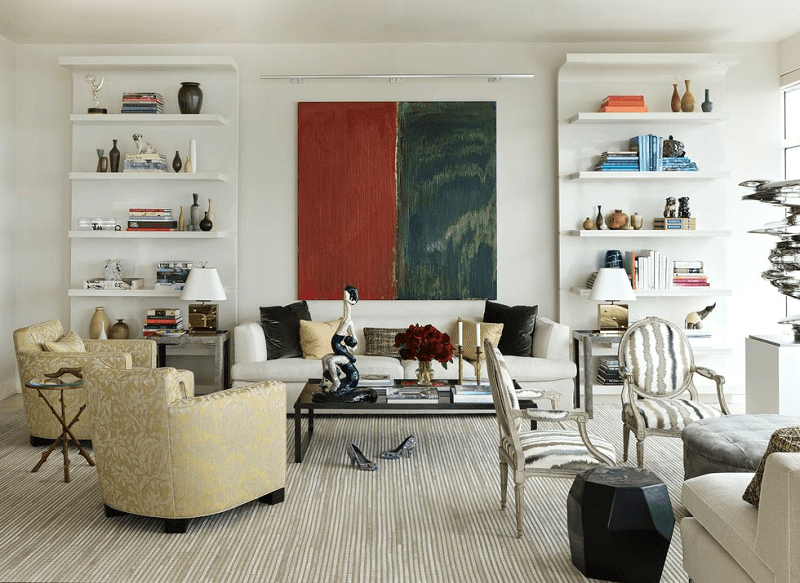
When it comes to area rugs, size matters. Choosing the right size rug is crucial for achieving a balanced and proportional look in your space. Here are 3 general guidelines.
3 General Guidelines:
- Living Room: In the living room, aim to have all the furniture sitting on the rug or at least the front legs of the furniture. This creates a unified and intimate seating area. If your living room is large, consider using multiple rugs to define different zones.
- Dining Room: The dining room rug should extend beyond the edges of the dining table, allowing enough space for chairs to slide in and out comfortably. Aim for a rug that is at least 24 inches larger than the table on all sides.
- Bedroom: In the bedroom, opt for a rug that extends 18-24 inches beyond the sides and foot of the bed. This creates a soft and cozy landing when you get out of bed in the morning.
Remember, these are general guidelines, and you can always adjust them based on your specific preferences and room dimensions.
“If you are looking for a way to style your space with wall art without breaking your piggy bank, then I recommend reading “10 Surprising Benefits of Printable Wall Art”
3. Consider the Rug Shape
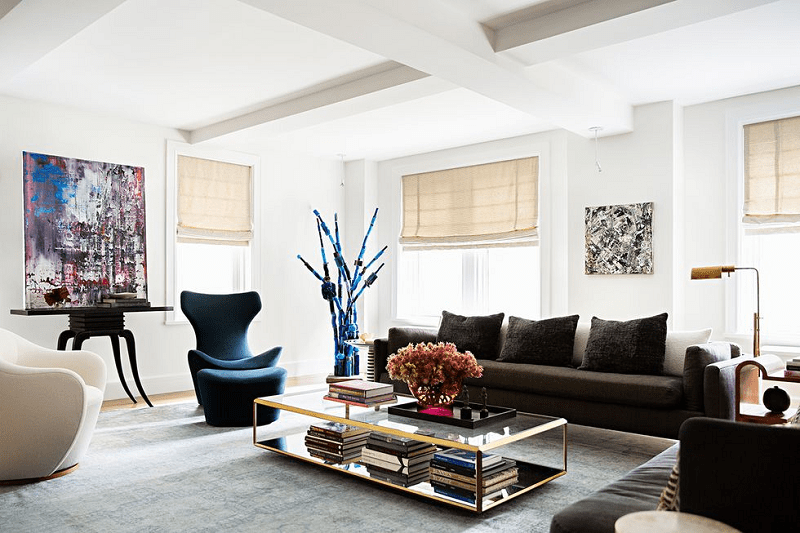
The shape of the rug can significantly impact the overall aesthetics of a room. While rectangular rugs are the most common choice, there are other shapes to consider:
- Rectangular: Rectangular rugs are versatile and work well in most rooms. They provide a clean and structured look, making them suitable for both traditional and contemporary decor styles.


- Round: Round rugs add a sense of playfulness and can soften the sharp edges of furniture. They are an excellent choice for entryways, dining areas, and rooms with curved furniture.


- Square: Square rugs can be an interesting alternative to rectangular ones, especially in rooms with a square layout. They create a sense of symmetry and balance, enhancing the overall design.


4. Determine the Rug Material
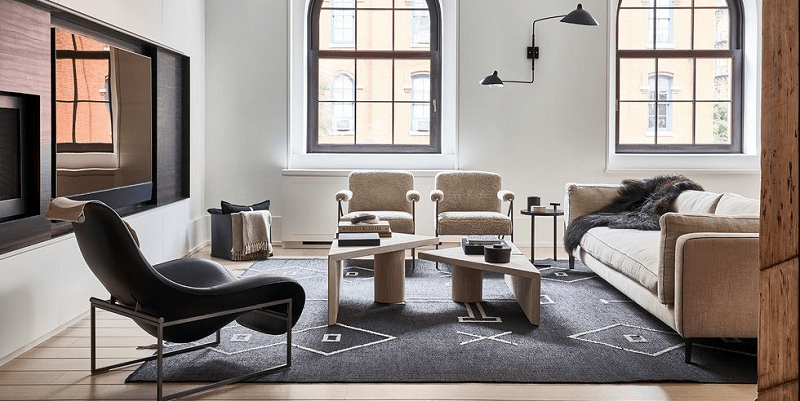
The material of an area rug affects its durability, texture, and maintenance requirements. Here are some popular rug materials and their characteristics:
“Area rugs are like magic carpets! They can instantly ground a space, define different areas within a room, and add warmth and texture underfoot. It’s like a finishing touch that brings everything together.”
Says Nate Berkus, renowned decorator
- Wool: Wool rugs are durable, soft, and naturally resistant to stains and odors. They provide excellent insulation and are a popular choice for high-traffic areas.


- Cotton: Cotton rugs are affordable, easy to clean, and come in a wide range of colors and patterns. They are best suited for low-traffic areas and spaces where comfort is a priority.


- Silk: Silk rugs are known for their luxurious feel and lustrous appearance. They add elegance to any room but require special care and are better suited for low-traffic areas.


- Synthetic: Synthetic rugs, such as polypropylene or nylon, are budget-friendly and easy to clean. They are often used in high-traffic areas due to their durability and stain resistance.


How to choose an area rug, you must consider the level of foot traffic, the presence of pets or children, and your personal preferences when selecting the material for your rug.
5. Choose the Right Colors and Patterns
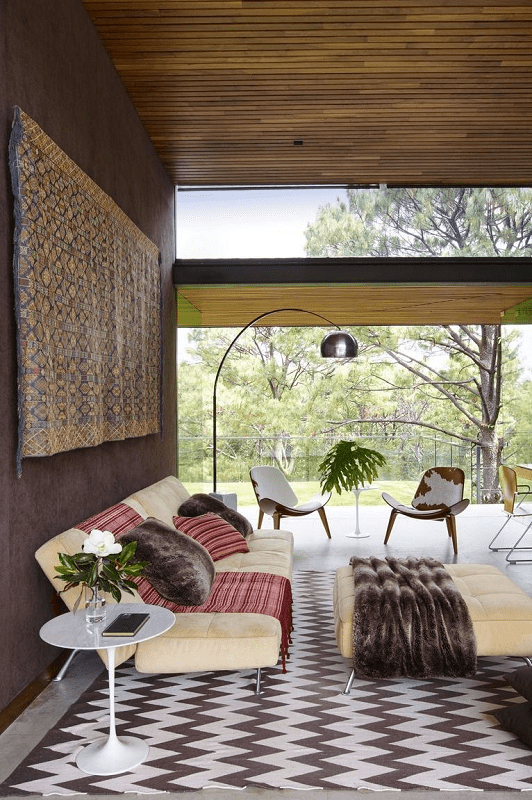
When choosing colors and patterns for your area rug, consider the existing color scheme and decor style of your room. Here are some tips on how to choose an area rug to guide you:
- Neutral Colors: Neutral-colored rugs, such as beige, gray, or ivory, are versatile and can seamlessly blend with various color palettes. They provide a calm and balanced backdrop, allowing other elements in the room to stand out.


- Bold Colors: If you want to make a statement or add a pop of color, opt for a rug with bold or vibrant hues. Just ensure that the colors harmonize with the rest of the room and do not overwhelm the space.


- Patterns: Patterns can add visual interest and personality to a room. Consider the scale of the pattern and how it will interact with other patterns or textures in the space. For example, if you have patterned furniture, a rug with a subtle pattern or solid color may be a better choice.


6. Layering Rugs for Added Depth
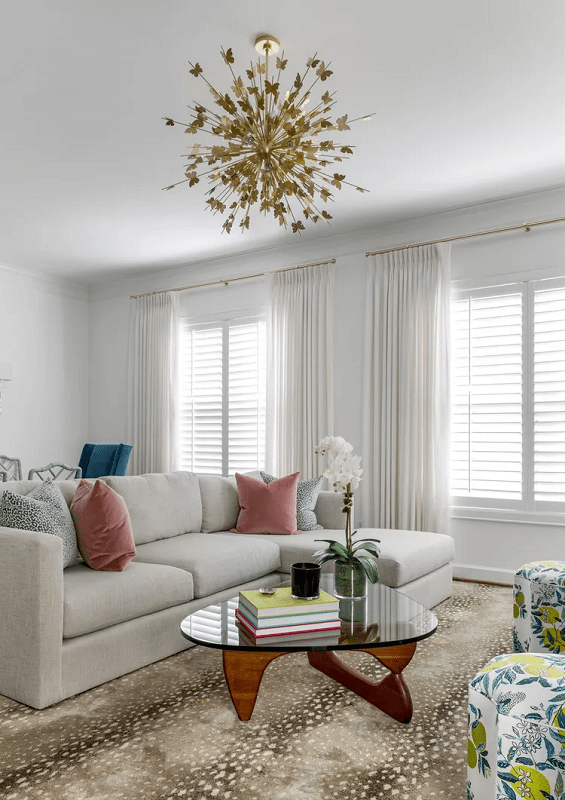
Layering rugs is a creative way to add depth and texture to your space. It involves placing one rug on top of another to create a visually appealing combination. Here are 3 rug layering ideas.
3 Ideas For Rug Layering:
- Contrasting Sizes: Choose a smaller rug with a bold pattern or texture and layer it on top of a larger, neutral-colored rug. This creates a focal point and adds visual interest to the room.
- Mixing Textures: Combine rugs with different textures, such as a plush rug layered over a sisal or jute rug. The contrasting textures add depth and dimension to the space.
- Playing with Shapes: Experiment with different rug shapes and layer them creatively. For example, place a round rug on top of a rectangular one, or overlap two rectangular rugs at an angle.
Layering rugs allows you to showcase your creativity and create a unique look that reflects your personal style.
7. Rug Maintenance and Care
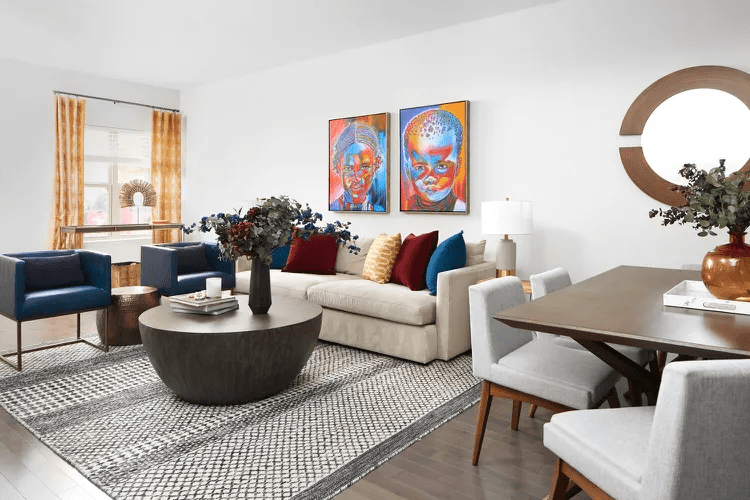
To ensure your area rug stays in optimal condition and lasts for years to come, it’s essential to follow proper maintenance and care practices. Here are 4 maintenance and care tips:
4 Tips to Care For Your Rug:
- Regular Vacuuming: Vacuum your rug regularly to remove dirt, dust, and debris. Use a vacuum cleaner with a brush attachment or a canister vacuum for delicate rugs.
- Spot Cleaning: Attend to spills or stains immediately to prevent them from setting in. Blot the affected area with a clean cloth or paper towel and use a mild detergent or a specialized rug cleaner if necessary. Avoid rubbing the stain, as it can spread and damage the fibers.
- Rotate the Rug: To ensure even wear, rotate your rug every six months, especially if it receives heavy foot traffic. This helps prevent certain areas from becoming worn or faded.
- Professional Cleaning: Periodically, have your rug professionally cleaned to remove deep-seated dirt and maintain its freshness and appearance. Consult a professional rug cleaner for the appropriate cleaning method based on the rug’s material and construction.
By following these maintenance tips, you can keep your area rug looking pristine and extend its lifespan.
Different Types of Area Rugs
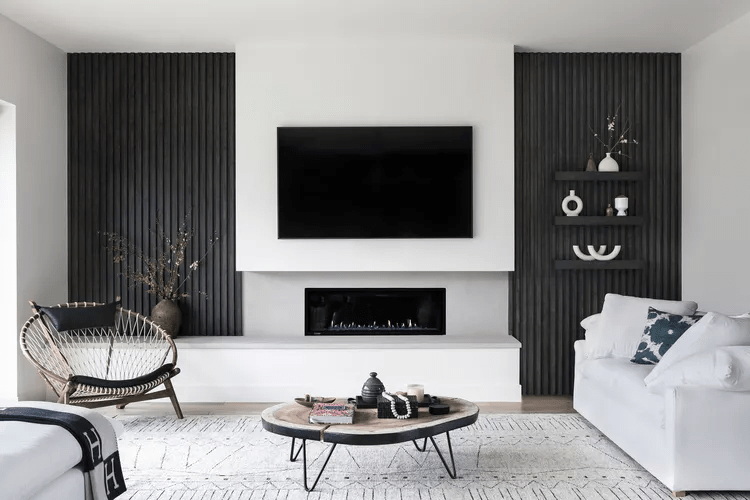
When it comes to how to choose an area rug for your home, there are various types available, each with its own unique characteristics and style. Understanding the different types of rugs can help you make an informed decision based on your preferences and needs. Here’s a list of popular types of rugs to consider.
8 Most Popular Types of Rugs to Consider:
- Area Rugs: Area rugs are versatile and can be used in various rooms and spaces. They come in a wide range of sizes, shapes, and materials, allowing you to find the perfect match for your home decor. Whether you prefer a traditional Persian rug, a modern geometric design, or a cozy shag rug, area rugs offer endless possibilities.
- Persian/Oriental Rugs: Persian or Oriental rugs are known for their intricate designs, rich colors, and timeless beauty. These rugs are traditionally hand-knotted and feature motifs and patterns that represent the cultural heritage of the region they originate from. Persian rugs add a touch of elegance and sophistication to any space.
- Modern/Contemporary Rugs: If you prefer a more sleek and minimalist look, modern or contemporary rugs are a great choice. These rugs often feature bold colors, geometric patterns, and abstract designs. They can add a pop of color and a sense of artistic flair to your room.
- Shag Rugs: Shag rugs are known for their long, fluffy pile that provides a cozy and luxurious feel underfoot. These rugs are perfect for creating a warm and inviting atmosphere in living rooms, bedrooms, or areas where comfort is a priority. Shag rugs are available in various materials, including wool, synthetic fibers, and even faux fur.
- Natural Fiber Rugs: Natural fiber rugs, such as jute, sisal, or seagrass, are popular for their organic and eco-friendly appeal. These rugs add texture and a rustic charm to your space. They are durable and work well in high-traffic areas.
- Kilim Rugs: Kilim rugs originate from Turkey, Iran, or other regions in the Middle East. They are flat-woven rugs that feature vibrant colors, intricate patterns, and geometric designs. Kilim rugs are lightweight and versatile, making them suitable for both traditional and modern interiors.
- Vintage and Antique Rugs: Vintage and antique rugs add character and a sense of history to your home. These rugs have a unique charm and often showcase traditional designs or faded colors that evoke a nostalgic feel. They can be heirloom pieces or sourced from antique markets.
- Outdoor Rugs: Outdoor rugs are designed to withstand the elements and are perfect for patios, decks, or outdoor living spaces. They are made from durable materials that resist fading and are easy to clean.
Final Note:
Consider the style, functionality, and maintenance requirements when selecting the type of rug that best suits your home. Each type of rug brings its own personality and can enhance the overall aesthetic of your space.
What Type of Rugs Are the Most Durable for Kids, Pets, and High-Traffic Areas?
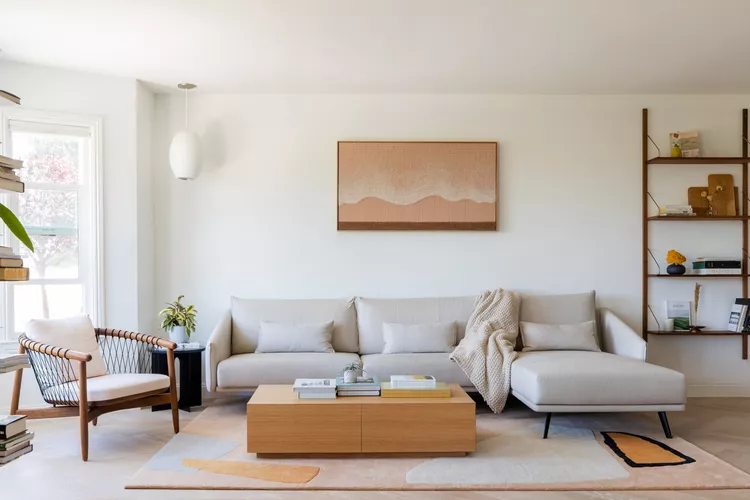
When selecting an area rug for spaces with kids, pets, or high foot traffic, durability becomes a crucial factor. You’ll want a rug that can withstand the demands of daily life while still maintaining its beauty. Here are some types of rugs known for their durability:
“Area rugs are one of the most versatile and functional pieces you can have in your home. They can hide imperfections, muffle noise, and create cozy zones for specific activities. Plus, they’re relatively easy to swap out for a fresh look whenever you crave a change.”
Says Justina Blakeney, design blogger and author
When choosing an area rug for your home, durability becomes a crucial factor, especially with kids, pets, or high foot traffic. You’ll want a rug that can withstand the demands of daily life while still maintaining its beauty. Here are some types of rugs known for their durability.
5 Most Durable Rugs:
- Wool Rugs: Wool rugs are renowned for their durability and resilience. Wool fibers are naturally resistant to stains, dirt, and crushing, making them an excellent choice for high-traffic areas. Additionally, wool rugs are known for their ability to bounce back and retain their shape even under heavy furniture or constant foot traffic. They are also soft and comfortable, making them suitable for kids and pets.
- Nylon Rugs: Nylon rugs are another popular choice for durability. They are highly resistant to wear and tear, making them ideal for areas with high foot traffic. Nylon fibers are also stain-resistant and easy to clean, which is beneficial when dealing with spills or accidents from kids or pets. These rugs come in a wide range of styles and designs, offering versatility for various decor preferences.
- Polypropylene Rugs: Polypropylene, a synthetic fiber, is known for its exceptional durability and resistance to stains and fading. These rugs are budget-friendly options that are perfect for households with kids and pets. Polypropylene rugs are easy to clean and maintain, making them a practical choice for busy areas. They come in various colors and designs, including options that mimic the look and feel of natural fibers like wool.
- Sisal or Seagrass Rugs: Natural fiber rugs like sisal or seagrass are sturdy and well-suited for high-traffic areas. They have a textured surface that hides dirt and stains effectively. Sisal and seagrass rugs are also known for their durability and resistance to wear and tear. However, keep in mind that these rugs may not be as soft underfoot compared to other materials, so they may not be the most comfortable option for young children.
- Indoor/Outdoor Rugs: Indoor/outdoor rugs are specifically designed to withstand various weather conditions and heavy use. They are made from synthetic materials such as polypropylene or polyester, which make them resistant to fading, moisture, and stains. These rugs are an excellent choice for areas with pets or kids, as they can be easily cleaned and are highly durable. They come in a wide range of styles and patterns, allowing you to find one that matches your decor.
Remember to consider the rug’s construction and pile height as well. For high-traffic areas, shorter pile rugs or flatweave rugs tend to be more resilient and easier to clean.
How Much Do Rugs Cost?
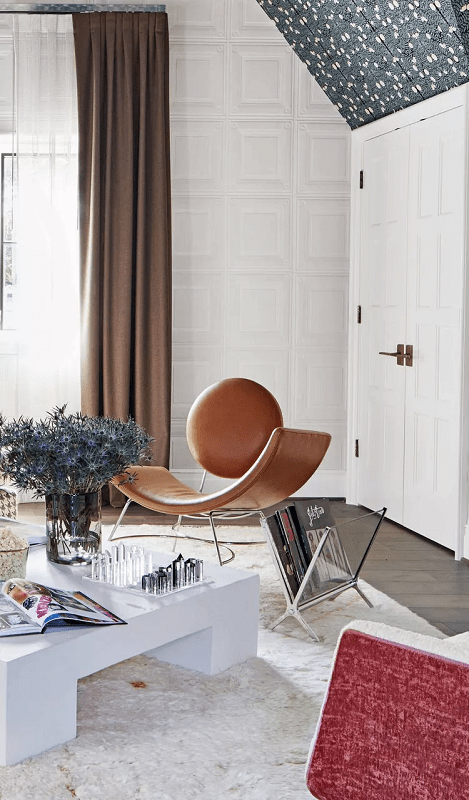
The cost of rugs can vary significantly depending on various factors such as the size, material, construction, and design. When considering how to choose an area rug, you’ll find that rugs come in a wide range of price points, from budget-friendly options to luxurious, high-end pieces.
Here is a breakdown of the general price ranges:
- Budget-Friendly Rugs: If you’re on a tight budget or looking for an affordable option, there are plenty of budget-friendly rugs available. These rugs are often made from synthetic materials like polypropylene or nylon, which make them more cost-effective. You can find small to medium-sized rugs in this range, typically ranging from $50 to $200.
- Mid-Range Rugs: Mid-range rugs offer a good balance between quality and price. These rugs are often made from natural materials like wool or cotton and may feature more intricate designs or patterns. Depending on the size and material, mid-range rugs generally range from $200 to $1000.
- High-End Rugs: For those seeking luxury and exceptional craftsmanship, high-end rugs are the way to go. These rugs are made from premium materials like silk or hand-knotted wool, and they often showcase intricate designs or unique patterns. High-end rugs can range from a few thousand dollars to tens of thousands of dollars, depending on factors such as size, material, and design complexity.
Final Note:
It’s important to note that these price ranges are general estimates, and the actual cost of a rug can vary based on various factors. Additionally, there are specialty rugs, antique rugs, or custom-made rugs that may fall outside of these price ranges.
When considering the cost of a rug, it’s essential to factor in the long-term value and durability. A high-quality rug may require a larger upfront investment but can last for many years with proper care.
Ultimately, the price of a rug is a personal decision based on your budget, style preferences, and the value you place on the aesthetics and functionality it brings to your home.
Best Places to Shop for Area Rugs
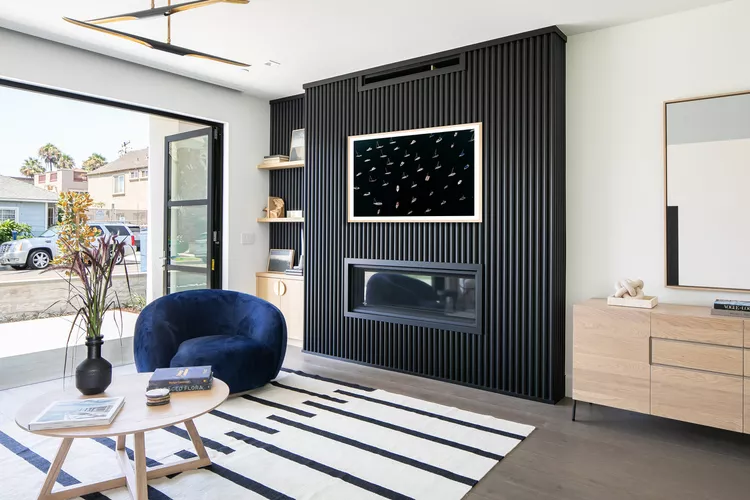
When it comes to finding the perfect area rug for your home, there are several places where you can shop and explore a wide variety of options. Whether you prefer in-person shopping or the convenience of online browsing, here are some of the best places to shop for area rugs:
“Area rugs are like jewelry for your floor. They can inject personality, pattern, and color into a space, making it feel more inviting and stylish. Plus, they add a layer of comfort and protect your hard floors.”
Says Kelly Wearstler, designer
6 Best Places to Shop For Area Rugs
- Local Rug Stores: Visiting local rug stores allows you to see and feel the rugs in person, providing a hands-on shopping experience. These stores often have knowledgeable staff who can guide you in choosing the right rug based on your preferences, budget, and specific requirements. Additionally, local stores may offer customization options or the ability to order rugs directly from manufacturers.
- Home Decor Retailers: Many home decor retailers, both brick-and-mortar and online, have a dedicated section for area rugs. Stores like HomeGoods, Wayfair, and Pottery Barn offer a wide selection of rugs in various styles, sizes, and price ranges. You can explore their collections and filter options based on material, color, and design to find the perfect rug for your home.
- Online Marketplaces: Online marketplaces such as Amazon, Overstock, and eBay provide a vast range of options for area rugs. These platforms offer the convenience of browsing through thousands of rugs from the comfort of your home. You can read customer reviews, compare prices, and take advantage of various filters to narrow down your search. Just be sure to check the return policy and verify the seller’s reputation before making a purchase.
- Rug Boutiques and Galleries: If you’re looking for unique, high-quality rugs, rug boutiques and galleries are worth exploring. These specialized stores often curate a collection of artisanal rugs, vintage pieces, or handcrafted designs. While these rugs may come at a higher price point, they offer exceptional craftsmanship and a one-of-a-kind aesthetic.
- Online Rug Retailers: Several online retailers focus specifically on rugs and offer a vast selection to choose from. Stores like RugsUSA, RugStudio, and RugSociety provide a wide range of styles, sizes, and materials. These retailers often have detailed product descriptions, customer reviews, and visual tools to help you envision how the rug will look in your space.
- Auction Houses and Estate Sales: If you’re interested in antique or vintage rugs, auction houses and estate sales can be a treasure trove. These events offer the opportunity to find unique, one-of-a-kind rugs that have a rich history. Participating in auctions or visiting estate sales can be an exciting way to acquire a special rug for your home.
Final Note:
When shopping for area rugs, take into account factors such as quality, durability, price, and the reputation of the seller. It’s also important to consider the return policy, shipping options, and any additional services offered, such as rug cleaning or customization.
By exploring these different places to shop for area rugs, you can find the perfect rug that complements your style, fits your budget, and adds warmth and character to your home.
Most Popular Post:
10 Surprising Benefits of Printable Wall Art
15 Must-Have Accessories For Styling A Coffee Table
How to Choose the Perfect Interior Color Scheme for Your Home
Expert Guide On How To Buy A Rug For Each Room
Conclusion
How to choose and arranging an area rug in your home is an art that requires careful consideration of various factors. By assessing the room’s purpose, determining the right size and shape, selecting appropriate colors and patterns, and understanding proper maintenance, you can create a visually stunning and harmonious space. Whether you want to add warmth, define zones, or enhance your decor, the perfect area rug can transform your home and make it truly yours.
So, don’t be afraid to experiment, mix and match, and let your creativity shine through as you choose and arrange an area rug in your home. With the right rug as the centerpiece, you’ll create an inviting and stylish environment that reflects your unique taste and personality.
How to Choose an Area Rug (FAQs)
Q: How do I determine the right rug size for my living room?
Measure the seating area in your living room and choose a rug size that allows all the furniture to sit on the rug or at least have the front legs on it. This creates a cohesive and intimate seating arrangement.
Q: Can I use an area rug in a small room without it overpowering the space?
Absolutely! Opt for a smaller rug that complements the size of the room and choose lighter colors or subtle patterns to create an illusion of more space.
Q: How do I keep my area rug from slipping on hardwood floors?
To prevent slipping, place a rug pad or non-slip rug gripper underneath your area rug. These provide traction and keep the rug securely in place.
Q: Can I use multiple area rugs in one room?
Yes, using multiple rugs can define different zones within a room or add visual interest. Ensure that the rugs complement each other in terms of color, style, and size.
Q: How often should I clean my area rug?
Regular vacuuming is essential to remove surface dirt and debris. As for deep cleaning, it depends on factors like foot traffic and the rug’s material. As a general guideline, professional cleaning once every 1-2 years is recommended.
Q: Can I use an outdoor rug indoors?
Yes, you can use an outdoor rug indoors, especially in high-traffic areas or spaces prone to spills or dirt. Outdoor rugs are designed to withstand harsh conditions and are often easy to clean.
Subscribe To Newsletter!
Subscribe now for an endless feed of inspirational women cave decor ideas, pampering rituals and more tips for curating your ultimate escape. Let’s get started on making your cozy refuge a reality – you so deserve this!
CATCH THE LATEST IN HOME DECOR TRENDS:

Steal These 15 Expert-Approved Decorating Secrets

How To Accessories Your Living Room

Small Space? 10 Ways To Make A Room Appear Bigger

Make Your space Look Expensive
GET CAUGHT UP ON ALL THE INSPIRING DECOR TIPS:

18 Fresh Decorating Ideas To Update Your Fireplace

How To Create An Art Gallery Wall

